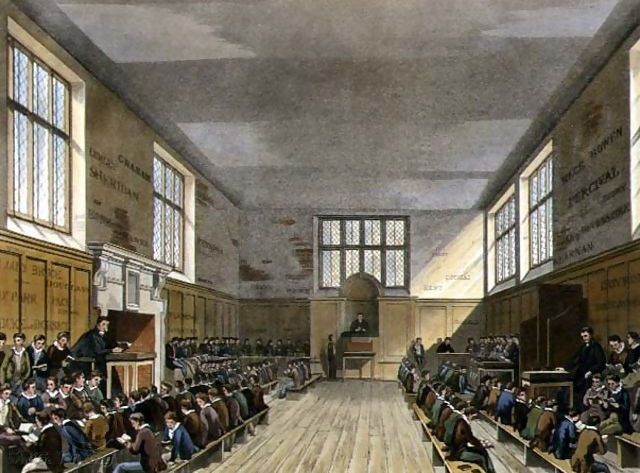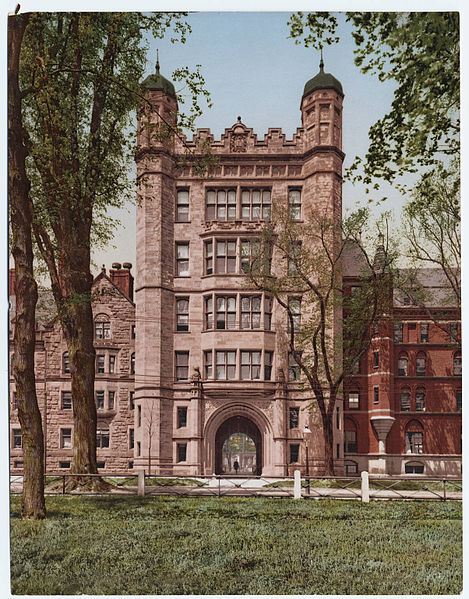
"Harrow School Room from History of Harrow School, part of History of the Colleges, engraved by Daniel Havell 1785-1826
A proper education normally confers social status in the United States. While not a guarantee, “the correlation between education and social status in contemporary American society is nevertheless a very high one,” Nisbet affirms. “Of all means of rising in the social scale, educational achievement has been historically one of the most effective.”1
Members of the American elites distinguish themselves from other classes by their education. William Domhoff relates:
“From infancy through young adulthood, members of the upper class receive a distinctive education. This education begins early in life in preschools that frequently are attached to a neighborhood church of high social status. Schooling continues during the elementary years at a local private school called a day school. The adolescent years may see the student remain at day school, but there is a strong chance that at least one or two years will be spent away from home at a boarding school….
“The linchpins in the upper-class educational system are the dozens of boarding schools that were developed in the last half of the nineteenth and the early part of the twentieth centuries…. Baltzell concludes that these schools became ‘surrogate families’ that played a major role ‘in creating an upper-class subculture on almost a national scale in America.’”2
Public schools were set up in the last century to give free education to the masses of immigrants. Zealous to preserve their manners and traditions, the upper classes established their own private educational institutions. Their boarding schools were inspired by English elite schools, such as Eton and Harrow, that have educated the British elites for centuries.3
According to John Ingham, these private schools fulfilled four social functions:
“First they isolated the children of older upper-class families into homogeneous environments where they did not have to mix with those from other social environments. Second, they ‘served the latent function of acculturating the members of the younger generation, especially those not quite to manor born, into an upper-class style of life.’ Third, these schools provided a convenient means for upper-class children from one city to meet and form lasting friendships with their upper-class counterparts in other cities. Finally, these schools, isolated in small towns and rural environments, provided an insulation from the increasingly urban and heterogeneous nature of their home communities.”4…
Domhoff writes in a similar vein.

Cabot House, named in honor of Harvard benefactors Thomas Cabot and Virginia Cabot, is one of twelve undergraduate residential Houses at Harvard University.
“This separate educational system is important evidence for the distinctiveness of the mentality and lifestyle that exists within the upper class, for schools play a large role in transmitting the class structure to their students. Surveying and summarizing a great many studies on schools in general, sociologist Randall Collins concludes: ‘Schools primarily teach vocabulary and inflection, styles of dress, aesthetic tastes, values and manners.’”5
Plinio Corrêa de Oliveira, Nobility and Analogous Traditional Elites in the Allocutions of Pius XII: A Theme Illuminating American Social History (York, Penn.: The American Society for the Defense of Tradition, Family, and Property, 1993), Appendix I, pp. 169-172.
1 Robert A. Nisbet, The Social Bond: An Introduction to the Study of Society (New York: Alfred A. Knopf, 1970), p. 194.
2 G. William Domhoff, Who Rules America Now? (New York: Simon & Schuster, Inc., 1983; Touchstone, 1986), pp. 24-25, quoting E. Digby Baltzell, Philadelphia Gentlemen: The Making of a National Upper Class (New York: The Free Press, 1958), p. 339.
3 Cf. Vance Packard, The Status Seekers (New York: David McKay Co., 1959), p. 237.
4 John Ingham, The Iron Barons: A Social Analysis of an American Urban Elite, 1874-1965 (Westport, Conn.: Greenwood Press, 1978), p. 93, quoting James McLachlan, American Boarding Schools: A Historical Study (New York: Scribners, 1970), p. 280.
5 Domhoff, Who Rules America Now? p. 24, quoting Randall Collins, “Functional and Conflict Theories of Educational Stratification,” American Sociological Review, Vol. 36, 1971, p. 1010.










